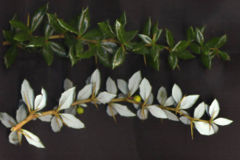Berberis verruculosa
| Berberis verruculosa subsp. var. | ||||||||||||||||||||||||||||||||||||||||||||||||||||||||
|---|---|---|---|---|---|---|---|---|---|---|---|---|---|---|---|---|---|---|---|---|---|---|---|---|---|---|---|---|---|---|---|---|---|---|---|---|---|---|---|---|---|---|---|---|---|---|---|---|---|---|---|---|---|---|---|---|

|
|
| ||||||||||||||||||||||||||||||||||||||||||||||||||||||
| ||||||||||||||||||||||||||||||||||||||||||||||||||||||||
| Standard Cyclopedia of Horticulture |
|---|
|
Berberis verruculosa, Hemsl. & Wilson. Dwarf, spreading shrub, to 3 ft., evergreen: branches terete, densely verruculose, with slender spines often as long as Lvs. : Lvs. ovate or elliptic to ovate - lanceolate, remotely spiny-toothed, dark green and lustrous above, glaucous beneath, ½-1 in. long: fls. 1-2, ½ in. across: fr. violet- black, bloomy, ovoid ⅓ in. long, with sessile stigma. June; fr. Oct. W. China. B.M. 8454.—Very handsome with its dense dark green and lustrous foliage. Has proved hardy at the Arnold Arboretum.
|
| Berberis verruculosa {{{status}}} Fossil range: {{{fossil_range}}}
| ||||||||||||||||||||||||||||||||||||||||||||||||||||||||||||||||||
|---|---|---|---|---|---|---|---|---|---|---|---|---|---|---|---|---|---|---|---|---|---|---|---|---|---|---|---|---|---|---|---|---|---|---|---|---|---|---|---|---|---|---|---|---|---|---|---|---|---|---|---|---|---|---|---|---|---|---|---|---|---|---|---|---|---|---|
 Upper side of shoot above, lower side below, with flower buds | ||||||||||||||||||||||||||||||||||||||||||||||||||||||||||||||||||
| Plant Info | ||||||||||||||||||||||||||||||||||||||||||||||||||||||||||||||||||
| ||||||||||||||||||||||||||||||||||||||||||||||||||||||||||||||||||
| Scientific classification | ||||||||||||||||||||||||||||||||||||||||||||||||||||||||||||||||||
| ||||||||||||||||||||||||||||||||||||||||||||||||||||||||||||||||||
| [[{{{diversity_link}}}|Diversity]] | ||||||||||||||||||||||||||||||||||||||||||||||||||||||||||||||||||
| {{{diversity}}} | ||||||||||||||||||||||||||||||||||||||||||||||||||||||||||||||||||
| Binomial name | ||||||||||||||||||||||||||||||||||||||||||||||||||||||||||||||||||
| Berberis verruculosa Hemsl. & Wils. | ||||||||||||||||||||||||||||||||||||||||||||||||||||||||||||||||||
| Trinomial name | ||||||||||||||||||||||||||||||||||||||||||||||||||||||||||||||||||
| {{{trinomial}}} | ||||||||||||||||||||||||||||||||||||||||||||||||||||||||||||||||||
| Type Species | ||||||||||||||||||||||||||||||||||||||||||||||||||||||||||||||||||
| {{{type_species}}} | ||||||||||||||||||||||||||||||||||||||||||||||||||||||||||||||||||
| {{{subdivision_ranks}}} | ||||||||||||||||||||||||||||||||||||||||||||||||||||||||||||||||||
| [[Image:{{{range_map}}}|{{{range_map_width}}}|]] | ||||||||||||||||||||||||||||||||||||||||||||||||||||||||||||||||||
| Synonyms | ||||||||||||||||||||||||||||||||||||||||||||||||||||||||||||||||||
| {{{synonyms}}} |
Berberis verruculosa, common name the Warty Barberry, is an evergreen shrub, ranging in size from 1-2 m, native to western China. The leaves are 1.5-2 cm long, hard, leathery, glossy dark green above, vivid white below with stomatal wax; in cold winter weather, the leaves may turn purplish-green above on exposed shoots. The flowers are small, yellow, and mature into dark purple fruit 6-10 mm long. It gets its common name from its "warty" stems, that have rounded, more or less identical, raised spots. It thrives in shade or partial shade.
Cultivation and uses
It is popular as an ornamental plant, and grows well in any garden soil. Template:Ranunculales-stub